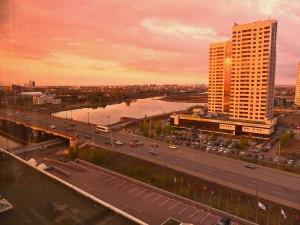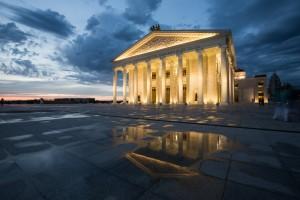
Astana – view across the river
But first I want to tell you about Astana, the capital city of Kazakhstan. And later I’ll tell you about kyz kuu, a kind of lovers’ kissing game they play on the steppe of central Asia.
Kazakhstan, independent since 1991, and squeezed between those other ‘stans’ (homelands) in central Asia – Kyrgyzstan, Turkmenistan and Uzbekistan – along with China, Russia and the Caspian Sea – is the ninth largest country in the world. It is positioned on a major junction of the ancient Silk Road, an increasingly sought-after trail for adventurous travellers.
The fast-developing 21st century city of Astana is the nation’s showpiece destination. It was a sleepy Russian provincial town before replacing Almaty as Kazakhstan’s capital in 1997. Since then, mainly Muslim Kazakhstan has set itself the goal of becoming the preeminent country in central Asia, with Astana as the jewel in the Kazakh crown.
Think of Dubai and you’ll get a picture of how Astana is developing. The Khan-Shatyr is a 150-metre tall, tent-like structure designed by Sir Norman Foster where well-dressed shoppers mingle among the luxury retail stores in balmy year-round temperatures of around 22 degrees. On one floor there is a beach, palm trees and wave pool. Perfect when it’s minus-35 outside.
Launched with a performance by Italian tenor Andrea Bocelli, Khan-Shatyr is just one of the eye-popping sights of Astana, an emerging powerhouse whose wealth is fueled by oil and gas and whose ambition is driven by its first and so far only president, Nursultan Nazarbayev, once a first secretary of the Kazakhstan Communist Party.
Today, visitors to another of Astana’s grand monuments, the 105-metre Bayterek Tower, topped by a huge sphere of glass that changes color depending on the light, can press their hands into the golden handprint of president Nazarbayev and make a wish. Many do.
Kazakhstan was once the fourth largest nuclear power in the world before unilaterally disarming after gaining independence from the Soviet Union. The Baikonur Cosmodrome was the launch site of Sputnik 1, the first man-made satellite; and the spot in 1961 from where cosmonaut Yuri Gagarin became the first man in space.
If you perceive Kazakhstan as an unsophisticated remnant of the Soviet empire, you would be doing it an injustice. Take one look inside Astana’s new breathtakingly beautiful, marble-embellished Opera House; or stand back to view the gilded domes of the Nur-Astana Mosque, and you’ll appreciate that this is not the place lampooned in movies by the likes of Sacha Baron Cohen.
The Opera House, which opened in October last year (2013), is a mix of classic Greco-Roman style and Kazakh design traditions. Swiss and Italian builders and designers worked with international architects to create a building that echoes the Bolshoi Theatre in Moscow.
Both this building, and Ak Orda, the flashy, presidential palace modeled on the White House in Washington, make big statements about Astana’s growing ambition in this part of the world.

Astana Opera House
If all this sounds a bit daunting, it shouldn’t. Kazakhstan is serious about attracting international visitors, and for those prepared to take the smallest of steps step outside their comfort zones the rewards are substantial.
“Expect the unexpected,” I’m told in a throaty, deep voice by a former KGB spy who masqueraded as a Russian Intourist guide in years gone by.
Kazakhstan, at the very crossroads of civilisations, has a big story to tell. It’s just that few have heard it because the country has been sheltered in the shadows of central Asia’s ‘stans’ and been unable to shatter some of the dark myths that surround these Soviet-era outposts.
Even today there is a certain amount of suspicion about Kazakhstan. When the Malaysian Airlines flight MH370 disappeared in mysterious circumstances in March, there were persistent rumours that it had been hijacked and flown to a remote spot in the Kazakh steppe.
In a way, though, Kazakhstan’s place on the periphery of the world tourism map is its strongest card. As travellers search for new destinations beyond the mass tourism destinations, the lure of the unexpected becomes a big attraction.
Today, presidents, former political leaders (Tony Blair comes and goes and is rumoured to earn US$25 million for his advice)), minor royalty and international business czars drop by to seek favour with the country’s ruler and look for opportunities in the country’s vast mineral and energy sectors.
On a tour of the Opera House I study a photograph of the cast of a recent musical performance and pick out a familiar face among the elaborately dressed singers and dancers? Yes, it’s Tony Blair. The same Tony Blair captured in a painting of world political leaders paying homage to president Nazarbayev, at the Museum of the First President.
Astana is the second coldest capital in the world after Ulaanbaatar, Mongolia. Winter temperatures, driven down by the searing winds from the endless grassy plains of the steppe, can reach minus 35 degrees Celsius, but days are dry and bright, providing prime conditions for winter sports. Summers can be scorchingly hot.
When the locals need a pick-me-up they head for a traditional sauna at the bathhouses. You may, however, want to skip one popular bathhouse ritual. It begins when one naked man flails the back of another naked man with a bunch of birch twigs. Others join in with the whipping, which is said to improve circulation.
Throughout the cold winters, tickets to the banyas (bath houses) – which have separate sections for men and women – sell out most nights, and on New Year’s Day the baths are packed to capacity as Kazakhs sweat away the dirt from the previous year and whip themselves into shape for the next. Helped, of course, by a shot or two of vodka.
Kazakh children grow up on a horse and the animal is ever present in daily life. In Astana I was told: “We have three types of horses here. One for working, one for riding and one for eating.” The drink of choice for the locals is kumys (fermented mare’s milk) or shubat (fermented camel’s milk),
A game called kyz kuu is also part of local folklore and involves a young man pursuing a woman on horseback. If he catches her before she rides across a finish line, he scores a kiss. Better not fail, though. The lady will turn her horse around, and thrash her lover energetically with a whip.
Kazakhs also play a traditional game with horses. Called kokpar, it involves scoring goals with a headless goat carcass. Kazakhstan won the first Asian kokpar championships, beating Kyrgyzstan in the final – four carcasses to two.
Horses and big feathery birds like falcons, eagles and vultures have always been very much part of Kazakh life. At an out-of-town falconry farm Igor (his other name was Paul, but Igor sounds much better) has a lined face that melts into the leather garments that protect him from the claws of the birds of prey under his control. Igor has a wry sense of humor.
When a bird pounces on a leather sandal lying on the ground, he explains that the sandal is all that’s left of a local waitress who was mistaken for prey.
The gulag labor camps were spread over the Kazakhstan steppe until the 1950s. The Alzhir camp, outside Astana, was reserved for Wives of Traitors of the Motherland, and housed 17,000 female prisoners at one point.
Both the massive Karlag at Dolinka and the Alzhir camp have retained small museums to remind visitors of the gruesome nature of the gulags.
Alexander Solzhenitsyn was a prisoner in Karlag, one of the worst of the camps. Solzhenitsyn drew on his experiences in the camp in the 1950s to write the gulag memoir, One Day in the Life of Ivan Denisovich.
A striking black and silver monument, the Arch of Grief, whose conical shape represents a traditional Kazakh bridal headdress, marks the museum entrance at Alzhir. Fragments of barbed wire and a watchtower are vivid symbols of the camp’s former role as a prison.
The camps were closed, although not immediately dismantled, after Stalin died in 1953.
Which finally brings me to the story of Stalin’s noses. When the despot died, Kazakhs set about destroying his statues. In the old capital Almaty the statues were dumped at a rubbish tip where officials knocked the nose off every statue to ensure they were never erected again.
Alexander Yezhov, then a teenage boy, now a grey-haired tour guide with crooked teeth, helped his Kazakh mates to steal Stalin’s broken noses. Caught in the act, they found a spot to bury them.
“One day someone will dig them up and wonder how all these noses of Stalin came to be buried in that spot,” he says.
Almaty, in the foothills of the Tien Shan Mountains, remains the financial and commercial centre, some 450km from the border with China. It is a compact, tree-shaded city, whose former name Alma-Ata means “father of apples”. “Forget New York, Almaty is the real Big Apple,” Baghdad, a colourful local character, tells me.
Almaty’s ethnic mix of Kazakhs, Uzbeks, Russians, Ukrainians, Chechens and Georgians can best be seen at the Green Market where there are Korean women selling salads, Uzbeks selling nuts and apricots, and Kazakhs selling apples and fresh horsemeat.
Oh yes, horsemeat. It’s a staple on most menus.
“Just get used to it,” Baghdad tells me.
And I do.

